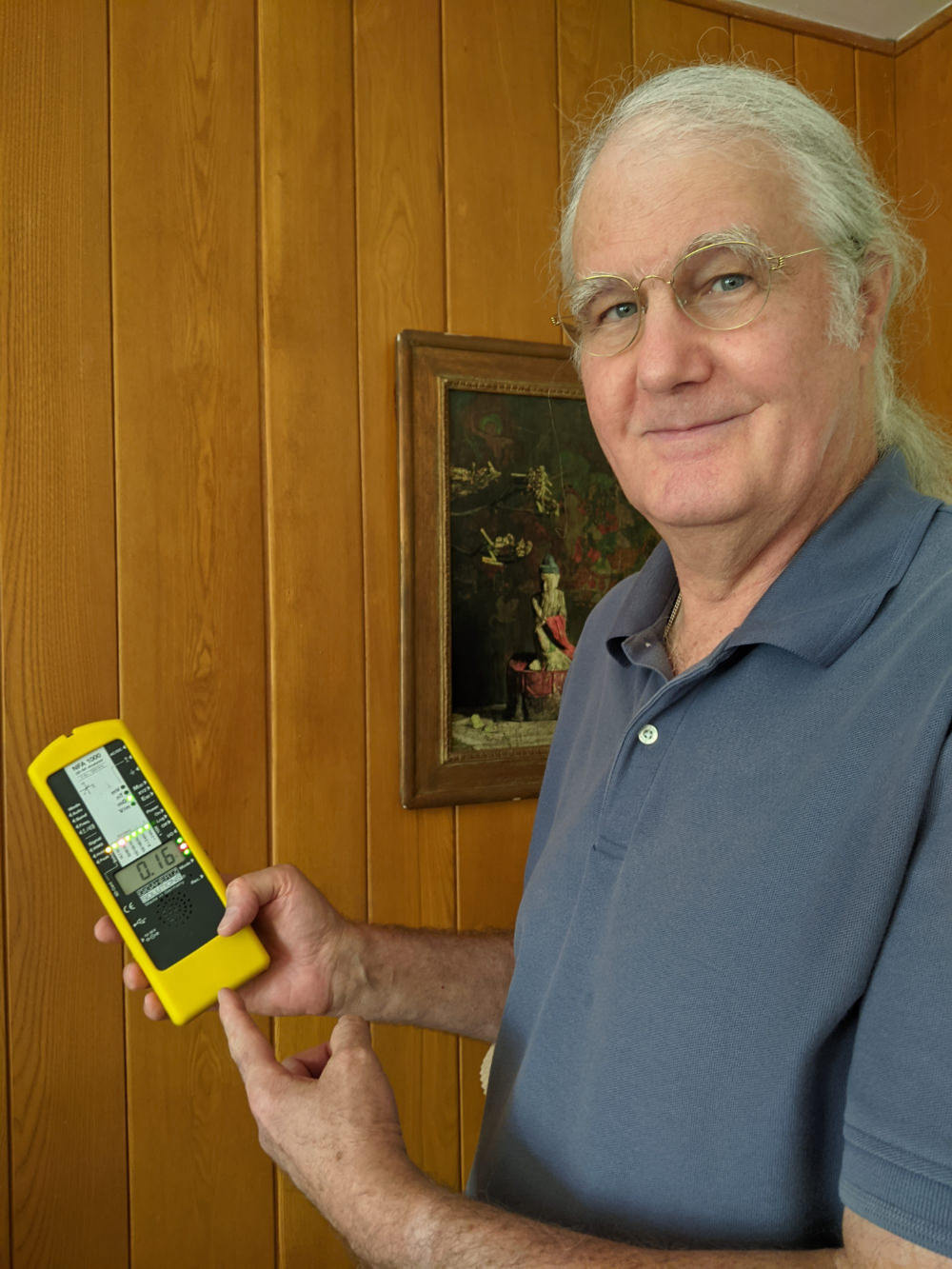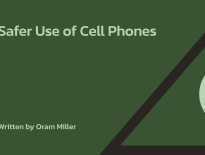Introduction
Electric fields are an anomaly in the EMF world. They are little known by most people, including those who are experts at EMFs. Most importantly, they are not known by those who suffer from their presence. Electric fields are the most common, but least understood or known type of EMF in a house. They are easy to measure and relatively easy to mitigate.
The Source of this Information
Everything I am about to say comes from the profession that taught and certified me; that is, the North American branch of the worldwide Bau Biologie profession. The mother profession is based in Germany, having arisen from the need to find healthy alternatives to the fast re-building of their housing stock in the late 1940s and 1950s, which caused illness among many people in Germany from mold, chemical outgassing and exposure to electromagnetic fields. Not that those things didn’t exist earlier, but they abounded with the use of construction methods that are, unfortunately, still widely used in North America that to this day cause marked degrees of toxicity. We never have a shortage of clients who contact those of us in practice as building biologists, as we are called in the US and Canada, because we work with clients who are sensitive to and affected by these various sources of toxicity. We are all busy without the need to advertise our services.
I work with clients virtually every day who are indeed sensitive to and affected by electromagnetic fields in all their manifestations. I am on the faculty for the North American branch of the Bau Biologie profession, known as the Building Biology Institute. I am also Director of Learning and Development. The profession’s website in North America is www.buildingbiologyinstitute.org. For information on attending seminars that lead toward certification to become an Electromagnetic Radiation Specialist, or EMRS, go to the Certifications page on the BBI website, by clicking here.
AC Electric Fields are One of Four Types of EMFs Recognized by Building Biology
What I was taught by the electrical engineers who taught the Eletromagnetic Radiation, or EMR, seminar that I took in 2003 is the same thing we now teach at our present courses that I help teach. We teach that there are four types of EMFs present in homes throughout the country and industrialized world. They are: AC magnetic fields from house wiring; AC electric fields from house wiring; radio frequency EMFs, which include all the wireless devices that we use today in our homes and from their outside transmitters, such as cell towers and radio transmitters; and fourth, so-called “dirty electricity”.
The Dual EMF Nature of Electricity
AC electricity comes into homes in North America at 60 Hz and 120 Volts. It has both an electric field and magnetic field component, hence the name “Electro Magnetic Fields”. Both components emit from all sources of electricity, whether it is a linear source, such as a wire, or a point source, such as a transformer or electric motor.
To help you understand the discussion on electric fields better, I urge you to view diagrams explaining electric and magnetic fields and how they differ by clicking here and scrolling down to see the pertinent diagrams. These were created by Spark Burmaster, EE, BBEC, EMRS of Wisconsin, building biologist, electrical engineer and former faculty for the Building BiologyTM Institute (BBI) in Santa Fe, New Mexico.
Near Field Versus Far Field Influences
AC electric and AC magnetic fields are either coupled and work in concert (if one field increases, the other field increases by the same amount at the same time), or they are independent and uncoupled from one another. What determines whether they are coupled or uncoupled at the place where you measure is determined, according to the electrical engineers who taught me, by whether you are inside the near field or beyond the near field in what is known as the far field. The near field, I am told, is any distance within three wavelengths associated with the frequency of the EMF emitted at the source. (Some engineers reportedly say the far field starts at five wavelengths, but the consensus I hear is three wavelengths.)
It turns out that the wavelength for AC electricity in North America in house wiring at 60 Hz is 3,100 miles. That means, the far field does not even start until you get to over 9,000 miles away, which for all practical purposes is the circumference of the earth. Thus, although the measurable field strength of the magnetic and electric field diminishes within a few feet or less from any wire or motor we are dealing with, nevertheless the far field begins so far away that we are always within the near field when it comes to the electric and magnetic field components of the EMFs coming into a room from AC electricity on house wiring or cords we plug in.
This means they are always uncoupled and you can have one without the other and vice versa. They also need to be measured with completely different instruments. You cannot measure electric fields with a Gauss meter, nor can you measure magnetic fields with the so-called “body voltage” meter nor with a good electric field meter. Some combination meters measure both, but you must set the meter to the type of field you want to measure.
Thus you can have AC electric fields present in a room where you have determined there are no AC magnetic fields. Furthermore, there are indeed health effects from long- and even short-term exposure to both of these fields, which differ somewhat from one another. Most people in the EMF Safety Community are aware of the adverse health effects from exposure to AC magnetic fields, but most people, even those who consider themselves to be EMF-aware or EMF sensitive, are totally unaware of the health effects of the electric field component of AC electricity.
The Extent of Electric Field Exposure in Homes
Yet, electric fields are by far the most common type of EMF caused by house wiring. I hear from many clients that they checked the “EMFs” in their bedroom and found none and moved on to the rest of the house. They either only used a Gauss meter, which again only measures magnetic fields but not electric fields, or they used a Tri-Field meter and may have switched it to the electric field setting and found no reading, and therefore assumed there were no electric fields.
It turns out the Tri-Field meter does not measure electric fields, or radio frequency field EMFs for that matter, at low enough levels, in our opinion, and therefore gives people the mistaken impression that there is no health risk, when in fact, there is. We have a table and description of safe exposure levels in the Building Biology profession that we teach our students to follow. You can download it here. I suggest you read that document carefully. The table was written by the German building biologists, and translated into English for us to use in North America with their blessing. It describes the three main types of EMFs we look for (AC magnetic fields, AC electric fields and radio frequency EMFs—dirty electricity is not on their list) and explains how the guidelines came into being and what various government agencies around the world say about safety limits for these types of EMFs (which is far higher than what we feel is safe). Unfortunately, the levels that we consider to be safe for AC electric field exposure are far lower than what the Tri-Field meter is capable of measuring.
If you go to Comments from Clients on my website here, you will see that most of the comments from actual clients I have worked with in California and throughout the country report improved sleep and increased energy when we measure electric field levels in their bedrooms and teach them how to reduce them at night. These bedrooms did not have elevated AC magnetic field readings in most cases. Just electric fields.
Once again, electric fields are the “unknown EMF” and yet they are the most common type found in a home. They rob you of a good night’s sleep. Go to my power point presentation here and scroll down to the section on AC Electric Fields to see the slides that discuss this type of EMF. They include a list of the health effects that clear up when this type of EMF is reduced.
How AC Electric Fields Are Created
In a nutshell, electric fields are caused by voltage, not current. When you turn on a breaker, it is like opening a spigot for a garden house, Now you have 80 pounds of pressure in the garden hose, yet you haven’t squeezed the nozzle. In the same way, when you turn the breaker on, you have 120 Volts of pressure in the circuit at all outlets, and when you plug in a lamp, it is like adding a six-foot length of hose and moving the nozzle to the end of it.
When you squeeze the nozzle of a water hose, water shoots out because of the pressure. Likewise, when you switch on a lamp, the light bulb turns on. When you let go of the nozzle, everyone has had the experience of feeling a kick in the hose at the nozzle, due to the continued 80 pounds of pressure in the hose right up to the nozzle in your hand.
In the lamp, that 120 Volts of pressure is still present in the plastic lamp cord right up to the switch just below the light bulb. When you turn that off, the pressure, caused by 120 Volts of pressure is still there in the plastic AC power cord that runs from the outlet up inside the lamp to the switch at the light bulb. This voltage is present whether the light bulb is on or off. You can verify this by placing a voltage tester, used by every electrician, next to the plastic lamp cord even with the light bulb turned off. It still beeps, indicating the continued presence of voltage, until you unplug the lamp (or shut off the breaker).
Qualities of AC Electric Fields
You can also verify this by using one of the testing methods we teach to measure the electric field present in a room from AC voltage in plastic-jacketed Romex circuits in walls or on a plastic AC lamp cord or extension cord. These fields from voltage in all of these wires pass right through sheetrock and through the air in the room, extending out six to eight feet, dropping off in intensity as you gradually move away from the source. The field is strongest closest to the wire, and lowest farther away.
This field is present in every room in a typical house wired with plastic, AC Romex circuits. Electric fields are also present when plastic AC power cords are plugged in. In the daytime, we can handle the health effects of being in proximity of these cords, but at night when we sleep, we don’t want to sleep in these electric fields. This is because the AC voltage field changes polarity from positive to negative at a rate of 120 times per second. This is because the sine wave of each cycle has two components, a positive phase and a negative phase.
The Extent of Electric Fields
The electric field from any given circuit or cord extends out 6-8 feet and then fully collapses, then extends out again with the opposite polarity. This is repeated again and again, 120 times a second. When this field expands and collapses 120 times a second, alternating in polarity, then the charged particles within our body’s cells, including the ions in our mitochondria, cell membranes and elsewhere, are washed in this strong polarized field coming into the body from outside. This adversely affects the proper functioning of these metabolic processes.
Adverse Health Effects from Sleeping in Bedrooms with High Electric Field Levels
This results in diminishing of certain beneficial processes that normally should happen at night when we sleep for our general health and well being. These include the release of melatonin by the pineal gland in the middle of the night and the depth to which our physiology drops during each ninety-minute sleep cycle. We move through roughly four to five ninety-minute cycles per night, passing from shallow Stage One to deep Stage Four sleep and back to Stage One again, followed by 15 minutes or so of dreaming. That takes roughly ninety minutes. Then the cycle repeats itself.
The more time we spend in deep Stage Four sleep every ninety-minute cycle, the more rested and refreshed we feel when we wake up during the day. Conversely, the less time we spend in deep Stage Four sleep every cycle, the less rested and refreshed we feel during the day.
Secondly, our pineal gland normally releases melatonin into our bloodstream in the middle of the night. The more melatonin we release each night, the better our physiology functions relative to our immune, nervous, endocrine and lymphatic systems. We can hold off hormone-dependent cancers, we produce more happy hormones, such as dopamine and seratonin, and we reduce fibromyalgia, allergies, headaches, insomnia, restless leg syndrome and even multiple chemical sensitivities, all when melatonin levels remain high during the night.
Unfortunately, the higher the electric field levels are in a bedroom, the less melatonin is released by the pineal gland and the less time we spend in deep Stage Four sleep. Our sleep remains shallow.
How We Manage Elevated Electric Fields in the Building Biology Profession
We measure the AC electric field levels in bedrooms and find the breakers that need to be turned off to bring those levels down sufficiently. Our goal is to reduce electric field exposure levels below 100 miliiVolts, as determined by what we call the “body voltage” test, or less than 1.5 Volts/meter as determined by a good quality triple axis electric field meter, such as the Gigahertz Solutions NFA1000. When that happens, clients’ symptoms clear up and they report improvements in sleep and levels of restfulness and activity during the day. See Comments from Clients here.
This is without magnetic fields being present in bedrooms. (When they are present along with elevated electric fields, then there are reports of an eleven-fold increase in cancer, and clients’ health is quite adversely affected. Elevated AC magnetic fields in bedrooms could come from wiring errors, current on grounding paths, such as water service pipes or incoming TV cable sheathing, or outside power lines. This is discussed in detail in my article on Magnetic Fields here).
You can see a video showing me measuring electric field levels using a body voltage meter. Go to EMF Help Center and then find the image of the body voltage meter, second from the left. Then scroll down and click on the link for the video. After an introduction of the use of the body voltage meter by the website’s founder, I begin a demonstration of the test at about minute 5:00.
Elevated nighttime electric fields in bedrooms in houses with metal-clad wiring are easier to mitigate than those wired with plastic-jacketed Romex circuits. With Romex, we have to shut off breakers every night. I identify those circuits for each client and ask them to try flipping them off manually at night at the breaker panel for a week or two. If they notice improvement, we have several ways to provide a convenient way to shut off these circuits at night remotely from inside the bedroom or house to continue the benefit each night but more conveniently.
In homes with metal-clad wiring, on the other hand, clients don’t need to shut off breakers. They just need to unplug cords for a few nights around their bed to see how they sleep. More permanently, they can use plug-in switches, or shut off a power strip that is made with shielded cord (these can be custom made), or have the bedside lamp rewired with shielded AC power cord such as MuCord from LessEMF.com. This is all discussed in the electric field section of my article EMF Meters and Instruments here.
We also look at electric field levels in day and evening use areas where people spend most of their time. This would include home offices and by your chair where you read or watch TV. I have an entire article that discusses how to identify and mitigate EMFs in home offices around computers.
Most people don’t realize that they are getting tired when using their laptop because it is ungrounded. This is true for half the PCs on the market, because they have two-pronged plugs on the AC power cord, or Mac users who remove the long cord with the three-pronged plug and instead slip on the two-pronged adapter and plug the transformer directly into an outlet or surge protector. Now in both cases, your electric field exposure levels are sky high and this drains your energy. Read the Electric Field section of the article, Safer Use of Computers here for specific information on how to identify and reduce electric fields around computers.
I also have a list of meters you can purchase or put together as a kit to measure AC electric fields yourself and a protocol you can download to learn how to do this in the Electric Field section of EMF Meters and Instruments here.
I have also written a series of articles for fellow building biologists Ron & Lisa Beres, based in Irvine, California for their blog, Healthy Home Dream Team. One of those articles is entitled, “Electric Fields, Melatonin from the Pineal Gland, and a Deep Night’s Sleep: What’s the Connection?”, that appeared September 2, 2010. It discusses one of the unknown causes of restless sleep, electric fields, and its connection to melatonin. To view the article, click here.
A follow-up article entitled, “Finally, a Good Night’s Sleep”, appeared December 11, 2010. It discusses steps to help you reduce and eliminate electric fields that rob us of a good night’s sleep. To view the article, click here.
I hope this has helped with your understanding of why we look at AC electric fields separate from AC magnetic fields in sleeping areas, and why doing so is considered a cornerstone of our work in the building biology profession. Providing a good night’s sleep for our clients is fundamental to our work. We need to create for our clients a sleeping environment that is devoid of AC electric fields, AC magnetic fields, radio frequency EMFs and dirty electricity.

BBEC, EMRS, Certified Building Biology™ Environmental Consultant and Electromagnetic Radiation Specialist and Healthy New Building and Remodeling Consultant. Providing On-Site EMF Evaluations for Existing and New Homes and Offices in Los Angeles, Orange, Ventura, Riverside and San Diego Counties and Nationwide by Telephone and Skype. Based upon the principles of Building Biology™.






